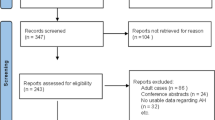Abstract
Purpose
This study aimed to analyze the clinical features of lumbar hernia reported in South Korea and compare these features with those reported in foreign literature.
Methods
From January 1968 through December 2013, 13 cases reported in South Korea were included in the study. The variables compared were age, sex, main symptoms at hospital visit, etiology, location, herniated contents, lateralization, defect size, diagnostic methods, surgical methods, surgical opinions, and recurrence.
Results
In the South Korean cases, women outnumbered men (3.3:1) and no significant differences were found in the herniated side (left:right, 1.1:1). In contrast, in the foreign cases, men outnumbered women (3:1) and left-sided hernia was dominant (2:1). Moreover, in most of the foreign cases, patients were aged 50–70 years, whereas in the South Korean cases, none of the patients were in their 50 s. However, no substantial differences were found in etiology, anatomical locations, symptoms, and herniated contents.
Conclusion
This research revealed that few clinical features of lumbar hernias in South Korea differ from those reported in foreign literature. Thirteen cases were analyzed in the present study, and results obtained from such a small sample size cannot be generalized with certainty. Therefore, more cases should be collected for a definitive analysis. Despite this limitation, this study is important because it is the first attempt to collect and analyze the clinical features of lumbar hernia in South Korea. This study will serve as a basis for future studies investigating the clinical features of lumbar hernia cases in South Korea.
Similar content being viewed by others
References
Chang KY, Chung ID, Hong WI, Chung JT (1968) A case of congenital lumbar hernia. J Korean Surg Soc 10:39–42
Paik NW, Kim YS (1969) Acquired lumbar hernia. J Korean Surg Soc 11:613–615
Chang YU (1974) Lumbar hernia (Grynfeltt type). J Korean Surg Soc 16:601–604
Shin DJ, Kim W, Lee DS, Song MH, Sung KY, Park IY, Won JM (1999) Superior lumbar hernia: a case report. J Korean Surg Soc 56:1052–1054
Park SG, Lim HG, Kim KT, Kim SH (2001) Two cases of lumbar hernia. J Korean Surg Soc 61:114–117
Park HR, Baek SK, Lee TS, Bae OS, Park SD (2006) Lumbar hernia combined with descending colon incarceration. J Korean Surg Soc 71:482–485
Chung M (2009) Post-traumatic lumbar hernia repaired with PHS (Prolene Hernia System). J Korean Surg Soc 77:221–224
Park CY, Hur YH, Kim JC, Kim SK (2009) Recurrence after repair of primary acquired Grynfeltt hernia. J Korean Surg Soc 77:149–152
Lee S, Chang HJ, Lee LH, Hong YR, Jung SW, Kim SK et al (2010) Superior lumbar hernia. J Korean Surg Soc 78:62–65
Lim MS, Lee HW, Yu CH, Yang DH (2011) Laparoscopic total extraperitoneal repair of lumbar hernia. J Korean Surg Soc 81:287–290
Nam SY, Kee SK, Km JO (2011) Laparoscopic transabdominal extraperitoneal mesh repair of lumbar hernia. J Korean Surg Soc 81:S74–S77
Baker ME, Weinerth JL, Andriani RT, Cohan RH, Dunnick NR (1987) Lumbar hernia: diagnosis by CT. AJR Am J Roentgenol 148:565–567
Guillem P, Czarmecki E, Duval G, Bounoua F, Fontaine C (2002) Lumbar hernia: anatomical route assessed by computed tomography. Surg Radiol Anat 24:53–56
Moreno-Egea A, Guzman P, Girela E, Corral M, Aguayo Albasini JL (2006) Laparoscopic hernioplasty in secondary lumbar hernia. J Laparoendosc Adv Surg Tech A 16:672–676
Light HG (1983) Hernia of the inferior lumbar space. a cause of back pain. Arch Surg 118:1077–1080
Skrekas G, Stafyla VK, Papalois VE (2005) A Grynfeltt hernia: report of a case. Hernia 9:188–191
Hide IG, Pike EE, Uberoi R (1999) Lumbar hernia: a rare cause of large bowel obstruction. Postgrad Med J 75:231–232
Moreno-Egea A, Baena EG, Calle MC, Martinez JA, Albasini JL (2007) Controversies in the current management of lumbar hernias. Arch Surg 142:82–88
Yang DH (2012) Lumbar hernia. J Herniol Diagn Treat 2:1–7
Moreno-Egea A, Alcaraz AC, Cuevo MC (2013) Surgical options in lumbar hernia: laparoscopic versus open repair. A long-term prospective study. Surg Innov 20:331–344
Conflict of interest
SP declares no conflict of interest.
SS declares no conflict of interest.
HC declares no conflict of interest.
Author information
Authors and Affiliations
Corresponding author
Electronic supplementary material
Below is the link to the electronic supplementary material.
Rights and permissions
About this article
Cite this article
Park, S.H., Chung, H.S. & Song, S.H. Lumbar hernia in South Korea: different from that in foreign literature?. Hernia 19, 835–839 (2015). https://doi.org/10.1007/s10029-014-1333-6
Received:
Accepted:
Published:
Issue Date:
DOI: https://doi.org/10.1007/s10029-014-1333-6




